HNC/HND Personal and Professional Development Report Analysis
VerifiedAdded on 2020/05/03
|39
|7164
|49
Report
AI Summary
This report delves into personal and professional development, examining two approaches to self-managed learning: training courses and home-based study. It proposes methods to encourage lifelong learning, such as self-awareness and adaptability, and evaluates workplace learning opportunities. The report includes a detailed skills audit, a personal development plan, and an action plan to address skill gaps. Furthermore, it evaluates the HNC/HND program experience and analyzes professional challenges, providing insights into leadership, motivation, and interpersonal skills. The report emphasizes the importance of aligning individual development with organizational goals and highlights areas for improvement in decision-making, delegation, and coaching.
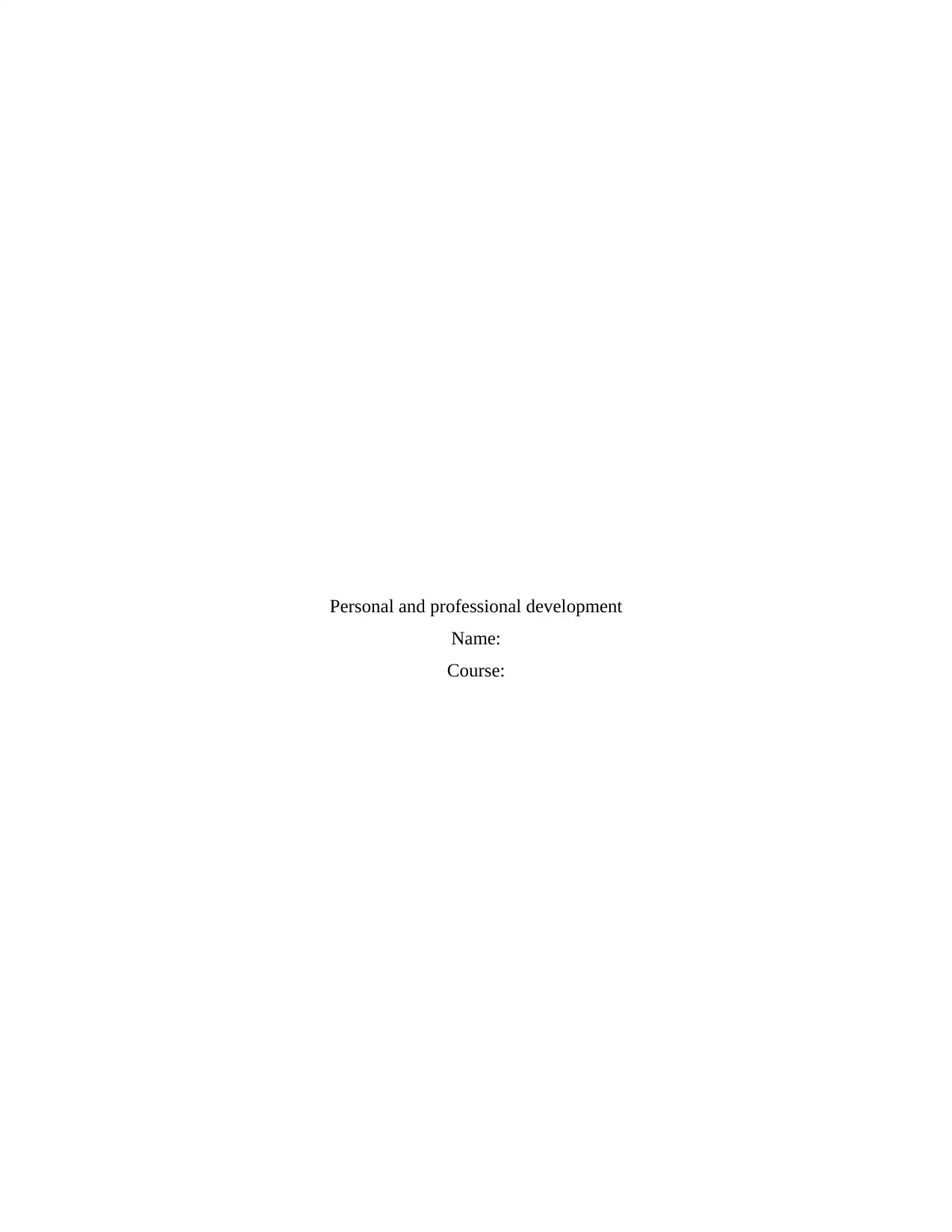
Personal and professional development
Name:
Course:
Name:
Course:
Paraphrase This Document
Need a fresh take? Get an instant paraphrase of this document with our AI Paraphraser
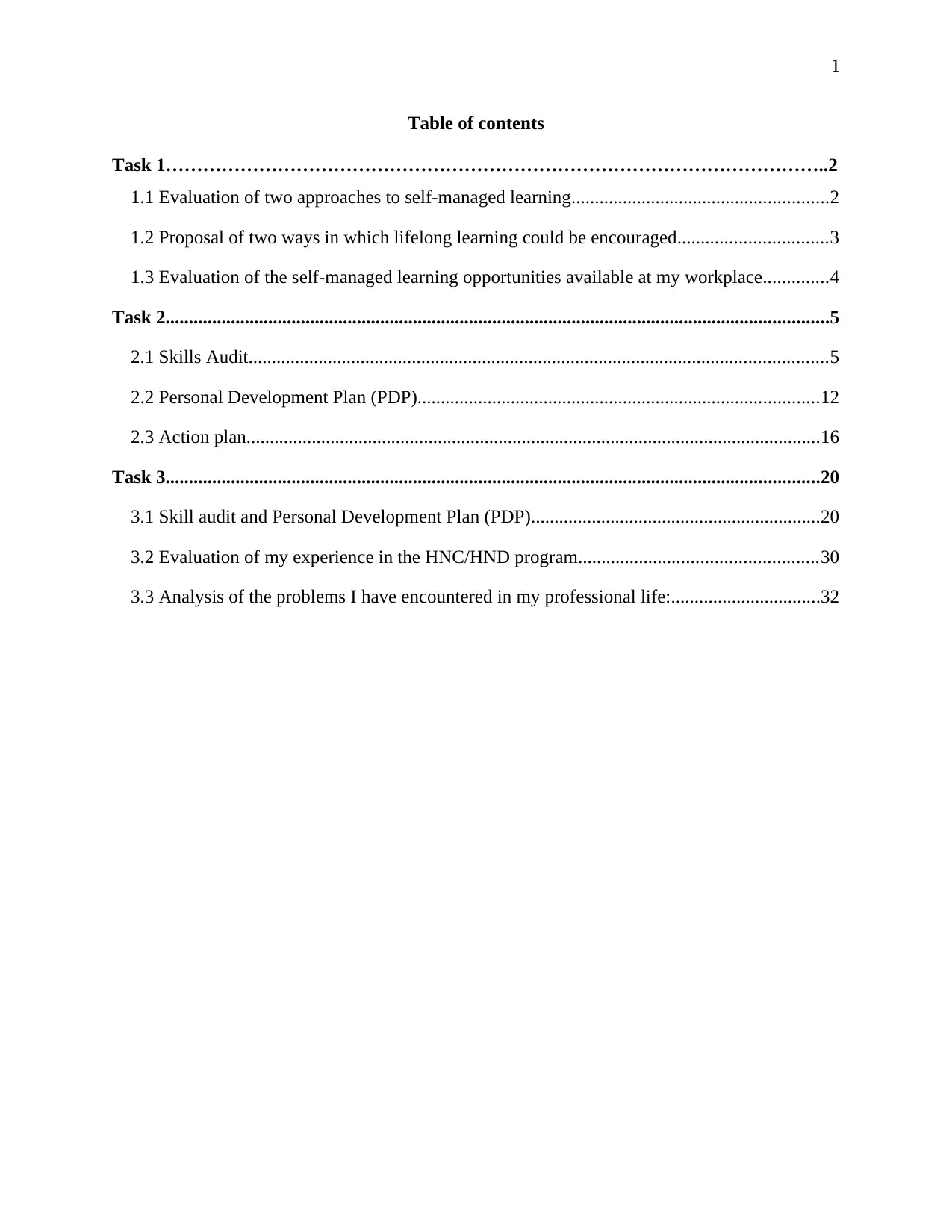
1
Table of contents
Task 1……………………………………………………………………………………………..2
1.1 Evaluation of two approaches to self-managed learning.......................................................2
1.2 Proposal of two ways in which lifelong learning could be encouraged................................3
1.3 Evaluation of the self-managed learning opportunities available at my workplace..............4
Task 2..............................................................................................................................................5
2.1 Skills Audit............................................................................................................................5
2.2 Personal Development Plan (PDP)......................................................................................12
2.3 Action plan...........................................................................................................................16
Task 3............................................................................................................................................20
3.1 Skill audit and Personal Development Plan (PDP)..............................................................20
3.2 Evaluation of my experience in the HNC/HND program...................................................30
3.3 Analysis of the problems I have encountered in my professional life:................................32
Table of contents
Task 1……………………………………………………………………………………………..2
1.1 Evaluation of two approaches to self-managed learning.......................................................2
1.2 Proposal of two ways in which lifelong learning could be encouraged................................3
1.3 Evaluation of the self-managed learning opportunities available at my workplace..............4
Task 2..............................................................................................................................................5
2.1 Skills Audit............................................................................................................................5
2.2 Personal Development Plan (PDP)......................................................................................12
2.3 Action plan...........................................................................................................................16
Task 3............................................................................................................................................20
3.1 Skill audit and Personal Development Plan (PDP)..............................................................20
3.2 Evaluation of my experience in the HNC/HND program...................................................30
3.3 Analysis of the problems I have encountered in my professional life:................................32
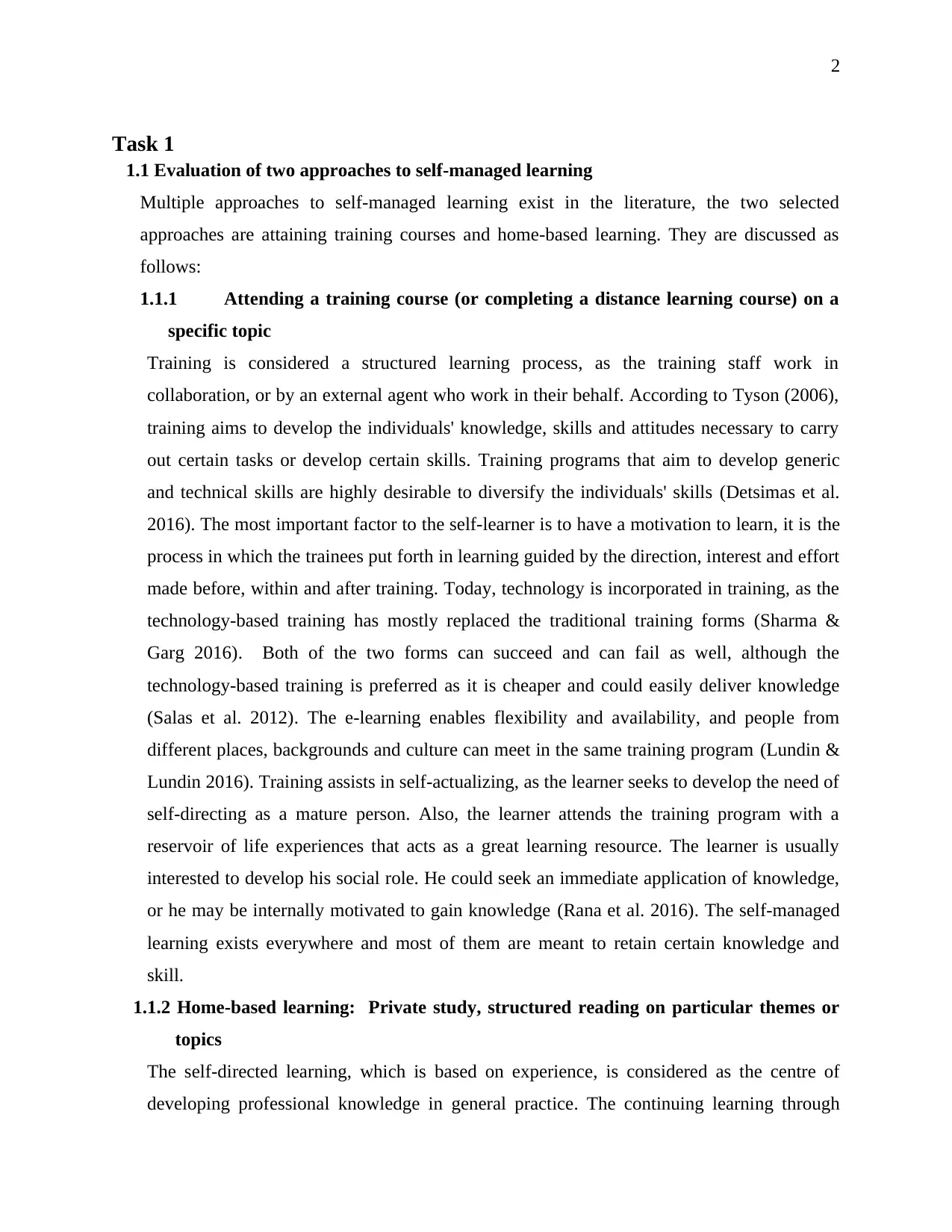
2
Task 1
1.1 Evaluation of two approaches to self-managed learning
Multiple approaches to self-managed learning exist in the literature, the two selected
approaches are attaining training courses and home-based learning. They are discussed as
follows:
1.1.1 Attending a training course (or completing a distance learning course) on a
specific topic
Training is considered a structured learning process, as the training staff work in
collaboration, or by an external agent who work in their behalf. According to Tyson (2006),
training aims to develop the individuals' knowledge, skills and attitudes necessary to carry
out certain tasks or develop certain skills. Training programs that aim to develop generic
and technical skills are highly desirable to diversify the individuals' skills (Detsimas et al.
2016). The most important factor to the self-learner is to have a motivation to learn, it is the
process in which the trainees put forth in learning guided by the direction, interest and effort
made before, within and after training. Today, technology is incorporated in training, as the
technology-based training has mostly replaced the traditional training forms (Sharma &
Garg 2016). Both of the two forms can succeed and can fail as well, although the
technology-based training is preferred as it is cheaper and could easily deliver knowledge
(Salas et al. 2012). The e-learning enables flexibility and availability, and people from
different places, backgrounds and culture can meet in the same training program (Lundin &
Lundin 2016). Training assists in self-actualizing, as the learner seeks to develop the need of
self-directing as a mature person. Also, the learner attends the training program with a
reservoir of life experiences that acts as a great learning resource. The learner is usually
interested to develop his social role. He could seek an immediate application of knowledge,
or he may be internally motivated to gain knowledge (Rana et al. 2016). The self-managed
learning exists everywhere and most of them are meant to retain certain knowledge and
skill.
1.1.2 Home-based learning: Private study, structured reading on particular themes or
topics
The self-directed learning, which is based on experience, is considered as the centre of
developing professional knowledge in general practice. The continuing learning through
Task 1
1.1 Evaluation of two approaches to self-managed learning
Multiple approaches to self-managed learning exist in the literature, the two selected
approaches are attaining training courses and home-based learning. They are discussed as
follows:
1.1.1 Attending a training course (or completing a distance learning course) on a
specific topic
Training is considered a structured learning process, as the training staff work in
collaboration, or by an external agent who work in their behalf. According to Tyson (2006),
training aims to develop the individuals' knowledge, skills and attitudes necessary to carry
out certain tasks or develop certain skills. Training programs that aim to develop generic
and technical skills are highly desirable to diversify the individuals' skills (Detsimas et al.
2016). The most important factor to the self-learner is to have a motivation to learn, it is the
process in which the trainees put forth in learning guided by the direction, interest and effort
made before, within and after training. Today, technology is incorporated in training, as the
technology-based training has mostly replaced the traditional training forms (Sharma &
Garg 2016). Both of the two forms can succeed and can fail as well, although the
technology-based training is preferred as it is cheaper and could easily deliver knowledge
(Salas et al. 2012). The e-learning enables flexibility and availability, and people from
different places, backgrounds and culture can meet in the same training program (Lundin &
Lundin 2016). Training assists in self-actualizing, as the learner seeks to develop the need of
self-directing as a mature person. Also, the learner attends the training program with a
reservoir of life experiences that acts as a great learning resource. The learner is usually
interested to develop his social role. He could seek an immediate application of knowledge,
or he may be internally motivated to gain knowledge (Rana et al. 2016). The self-managed
learning exists everywhere and most of them are meant to retain certain knowledge and
skill.
1.1.2 Home-based learning: Private study, structured reading on particular themes or
topics
The self-directed learning, which is based on experience, is considered as the centre of
developing professional knowledge in general practice. The continuing learning through
⊘ This is a preview!⊘
Do you want full access?
Subscribe today to unlock all pages.

Trusted by 1+ million students worldwide
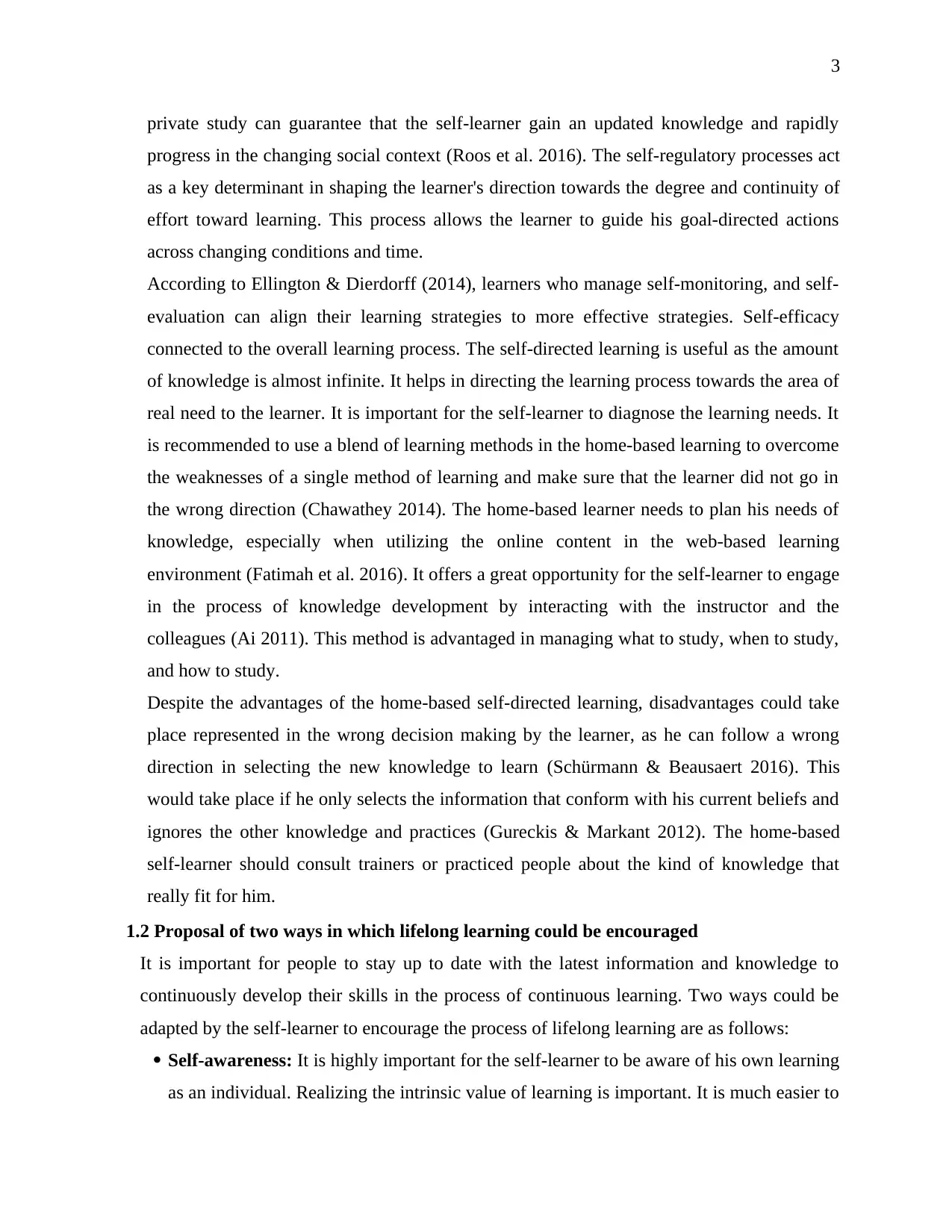
3
private study can guarantee that the self-learner gain an updated knowledge and rapidly
progress in the changing social context (Roos et al. 2016). The self-regulatory processes act
as a key determinant in shaping the learner's direction towards the degree and continuity of
effort toward learning. This process allows the learner to guide his goal-directed actions
across changing conditions and time.
According to Ellington & Dierdorff (2014), learners who manage self-monitoring, and self-
evaluation can align their learning strategies to more effective strategies. Self-efficacy
connected to the overall learning process. The self-directed learning is useful as the amount
of knowledge is almost infinite. It helps in directing the learning process towards the area of
real need to the learner. It is important for the self-learner to diagnose the learning needs. It
is recommended to use a blend of learning methods in the home-based learning to overcome
the weaknesses of a single method of learning and make sure that the learner did not go in
the wrong direction (Chawathey 2014). The home-based learner needs to plan his needs of
knowledge, especially when utilizing the online content in the web-based learning
environment (Fatimah et al. 2016). It offers a great opportunity for the self-learner to engage
in the process of knowledge development by interacting with the instructor and the
colleagues (Ai 2011). This method is advantaged in managing what to study, when to study,
and how to study.
Despite the advantages of the home-based self-directed learning, disadvantages could take
place represented in the wrong decision making by the learner, as he can follow a wrong
direction in selecting the new knowledge to learn (Schürmann & Beausaert 2016). This
would take place if he only selects the information that conform with his current beliefs and
ignores the other knowledge and practices (Gureckis & Markant 2012). The home-based
self-learner should consult trainers or practiced people about the kind of knowledge that
really fit for him.
1.2 Proposal of two ways in which lifelong learning could be encouraged
It is important for people to stay up to date with the latest information and knowledge to
continuously develop their skills in the process of continuous learning. Two ways could be
adapted by the self-learner to encourage the process of lifelong learning are as follows:
Self-awareness: It is highly important for the self-learner to be aware of his own learning
as an individual. Realizing the intrinsic value of learning is important. It is much easier to
private study can guarantee that the self-learner gain an updated knowledge and rapidly
progress in the changing social context (Roos et al. 2016). The self-regulatory processes act
as a key determinant in shaping the learner's direction towards the degree and continuity of
effort toward learning. This process allows the learner to guide his goal-directed actions
across changing conditions and time.
According to Ellington & Dierdorff (2014), learners who manage self-monitoring, and self-
evaluation can align their learning strategies to more effective strategies. Self-efficacy
connected to the overall learning process. The self-directed learning is useful as the amount
of knowledge is almost infinite. It helps in directing the learning process towards the area of
real need to the learner. It is important for the self-learner to diagnose the learning needs. It
is recommended to use a blend of learning methods in the home-based learning to overcome
the weaknesses of a single method of learning and make sure that the learner did not go in
the wrong direction (Chawathey 2014). The home-based learner needs to plan his needs of
knowledge, especially when utilizing the online content in the web-based learning
environment (Fatimah et al. 2016). It offers a great opportunity for the self-learner to engage
in the process of knowledge development by interacting with the instructor and the
colleagues (Ai 2011). This method is advantaged in managing what to study, when to study,
and how to study.
Despite the advantages of the home-based self-directed learning, disadvantages could take
place represented in the wrong decision making by the learner, as he can follow a wrong
direction in selecting the new knowledge to learn (Schürmann & Beausaert 2016). This
would take place if he only selects the information that conform with his current beliefs and
ignores the other knowledge and practices (Gureckis & Markant 2012). The home-based
self-learner should consult trainers or practiced people about the kind of knowledge that
really fit for him.
1.2 Proposal of two ways in which lifelong learning could be encouraged
It is important for people to stay up to date with the latest information and knowledge to
continuously develop their skills in the process of continuous learning. Two ways could be
adapted by the self-learner to encourage the process of lifelong learning are as follows:
Self-awareness: It is highly important for the self-learner to be aware of his own learning
as an individual. Realizing the intrinsic value of learning is important. It is much easier to
Paraphrase This Document
Need a fresh take? Get an instant paraphrase of this document with our AI Paraphraser
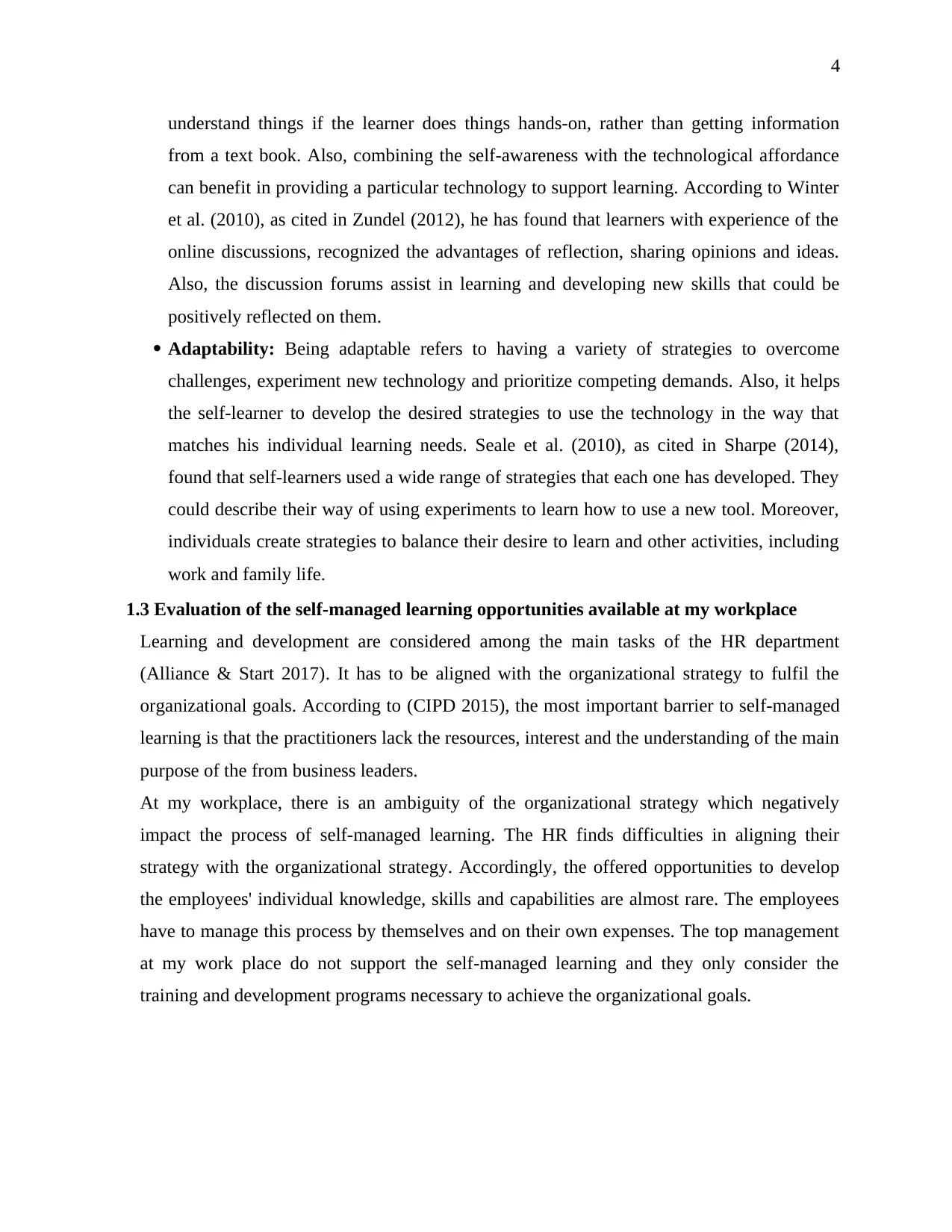
4
understand things if the learner does things hands-on, rather than getting information
from a text book. Also, combining the self-awareness with the technological affordance
can benefit in providing a particular technology to support learning. According to Winter
et al. (2010), as cited in Zundel (2012), he has found that learners with experience of the
online discussions, recognized the advantages of reflection, sharing opinions and ideas.
Also, the discussion forums assist in learning and developing new skills that could be
positively reflected on them.
Adaptability: Being adaptable refers to having a variety of strategies to overcome
challenges, experiment new technology and prioritize competing demands. Also, it helps
the self-learner to develop the desired strategies to use the technology in the way that
matches his individual learning needs. Seale et al. (2010), as cited in Sharpe (2014),
found that self-learners used a wide range of strategies that each one has developed. They
could describe their way of using experiments to learn how to use a new tool. Moreover,
individuals create strategies to balance their desire to learn and other activities, including
work and family life.
1.3 Evaluation of the self-managed learning opportunities available at my workplace
Learning and development are considered among the main tasks of the HR department
(Alliance & Start 2017). It has to be aligned with the organizational strategy to fulfil the
organizational goals. According to (CIPD 2015), the most important barrier to self-managed
learning is that the practitioners lack the resources, interest and the understanding of the main
purpose of the from business leaders.
At my workplace, there is an ambiguity of the organizational strategy which negatively
impact the process of self-managed learning. The HR finds difficulties in aligning their
strategy with the organizational strategy. Accordingly, the offered opportunities to develop
the employees' individual knowledge, skills and capabilities are almost rare. The employees
have to manage this process by themselves and on their own expenses. The top management
at my work place do not support the self-managed learning and they only consider the
training and development programs necessary to achieve the organizational goals.
understand things if the learner does things hands-on, rather than getting information
from a text book. Also, combining the self-awareness with the technological affordance
can benefit in providing a particular technology to support learning. According to Winter
et al. (2010), as cited in Zundel (2012), he has found that learners with experience of the
online discussions, recognized the advantages of reflection, sharing opinions and ideas.
Also, the discussion forums assist in learning and developing new skills that could be
positively reflected on them.
Adaptability: Being adaptable refers to having a variety of strategies to overcome
challenges, experiment new technology and prioritize competing demands. Also, it helps
the self-learner to develop the desired strategies to use the technology in the way that
matches his individual learning needs. Seale et al. (2010), as cited in Sharpe (2014),
found that self-learners used a wide range of strategies that each one has developed. They
could describe their way of using experiments to learn how to use a new tool. Moreover,
individuals create strategies to balance their desire to learn and other activities, including
work and family life.
1.3 Evaluation of the self-managed learning opportunities available at my workplace
Learning and development are considered among the main tasks of the HR department
(Alliance & Start 2017). It has to be aligned with the organizational strategy to fulfil the
organizational goals. According to (CIPD 2015), the most important barrier to self-managed
learning is that the practitioners lack the resources, interest and the understanding of the main
purpose of the from business leaders.
At my workplace, there is an ambiguity of the organizational strategy which negatively
impact the process of self-managed learning. The HR finds difficulties in aligning their
strategy with the organizational strategy. Accordingly, the offered opportunities to develop
the employees' individual knowledge, skills and capabilities are almost rare. The employees
have to manage this process by themselves and on their own expenses. The top management
at my work place do not support the self-managed learning and they only consider the
training and development programs necessary to achieve the organizational goals.

5
⊘ This is a preview!⊘
Do you want full access?
Subscribe today to unlock all pages.

Trusted by 1+ million students worldwide
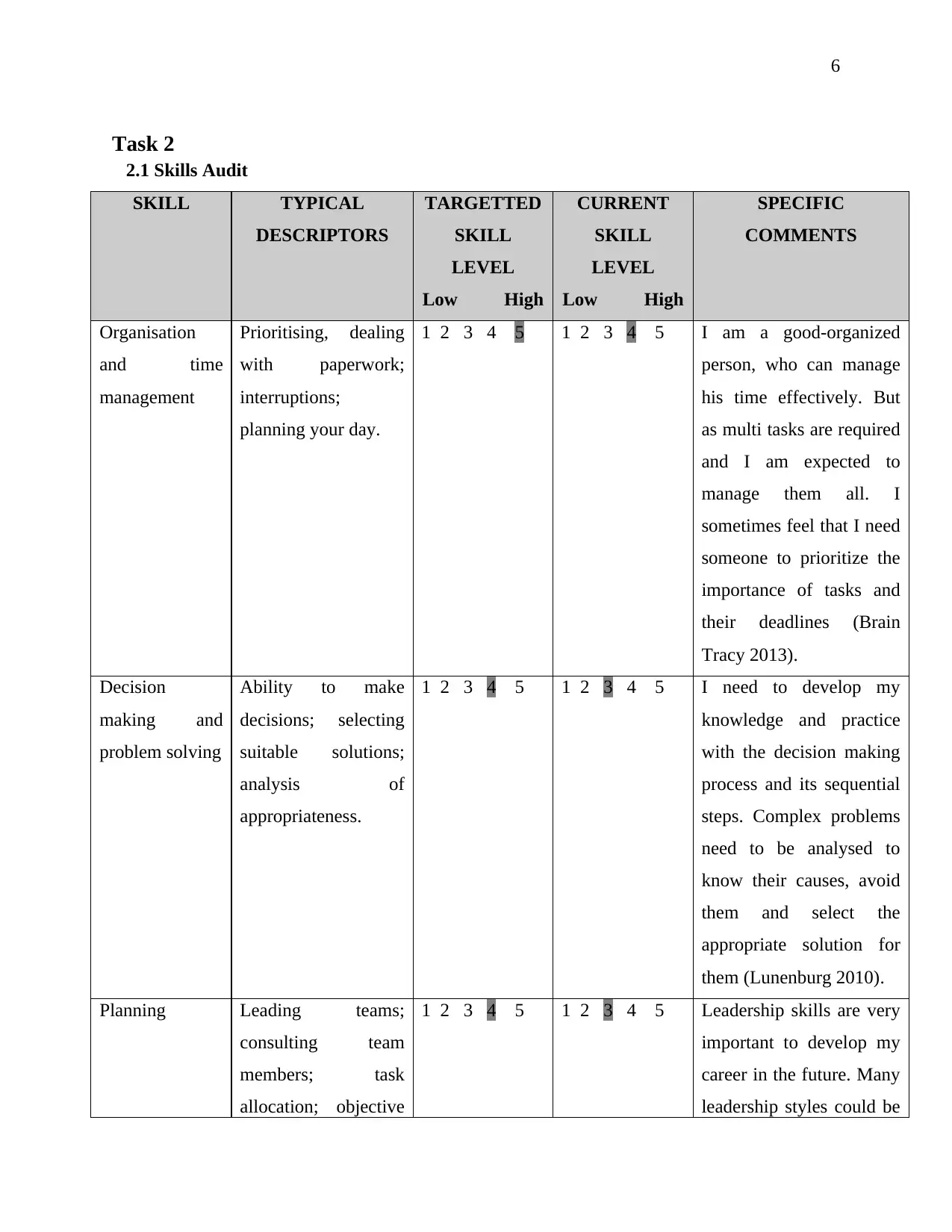
6
Task 2
2.1 Skills Audit
SKILL TYPICAL
DESCRIPTORS
TARGETTED
SKILL
LEVEL
Low High
CURRENT
SKILL
LEVEL
Low High
SPECIFIC
COMMENTS
Organisation
and time
management
Prioritising, dealing
with paperwork;
interruptions;
planning your day.
1 2 3 4 5 1 2 3 4 5 I am a good-organized
person, who can manage
his time effectively. But
as multi tasks are required
and I am expected to
manage them all. I
sometimes feel that I need
someone to prioritize the
importance of tasks and
their deadlines (Brain
Tracy 2013).
Decision
making and
problem solving
Ability to make
decisions; selecting
suitable solutions;
analysis of
appropriateness.
1 2 3 4 5 1 2 3 4 5 I need to develop my
knowledge and practice
with the decision making
process and its sequential
steps. Complex problems
need to be analysed to
know their causes, avoid
them and select the
appropriate solution for
them (Lunenburg 2010).
Planning Leading teams;
consulting team
members; task
allocation; objective
1 2 3 4 5 1 2 3 4 5 Leadership skills are very
important to develop my
career in the future. Many
leadership styles could be
Task 2
2.1 Skills Audit
SKILL TYPICAL
DESCRIPTORS
TARGETTED
SKILL
LEVEL
Low High
CURRENT
SKILL
LEVEL
Low High
SPECIFIC
COMMENTS
Organisation
and time
management
Prioritising, dealing
with paperwork;
interruptions;
planning your day.
1 2 3 4 5 1 2 3 4 5 I am a good-organized
person, who can manage
his time effectively. But
as multi tasks are required
and I am expected to
manage them all. I
sometimes feel that I need
someone to prioritize the
importance of tasks and
their deadlines (Brain
Tracy 2013).
Decision
making and
problem solving
Ability to make
decisions; selecting
suitable solutions;
analysis of
appropriateness.
1 2 3 4 5 1 2 3 4 5 I need to develop my
knowledge and practice
with the decision making
process and its sequential
steps. Complex problems
need to be analysed to
know their causes, avoid
them and select the
appropriate solution for
them (Lunenburg 2010).
Planning Leading teams;
consulting team
members; task
allocation; objective
1 2 3 4 5 1 2 3 4 5 Leadership skills are very
important to develop my
career in the future. Many
leadership styles could be
Paraphrase This Document
Need a fresh take? Get an instant paraphrase of this document with our AI Paraphraser
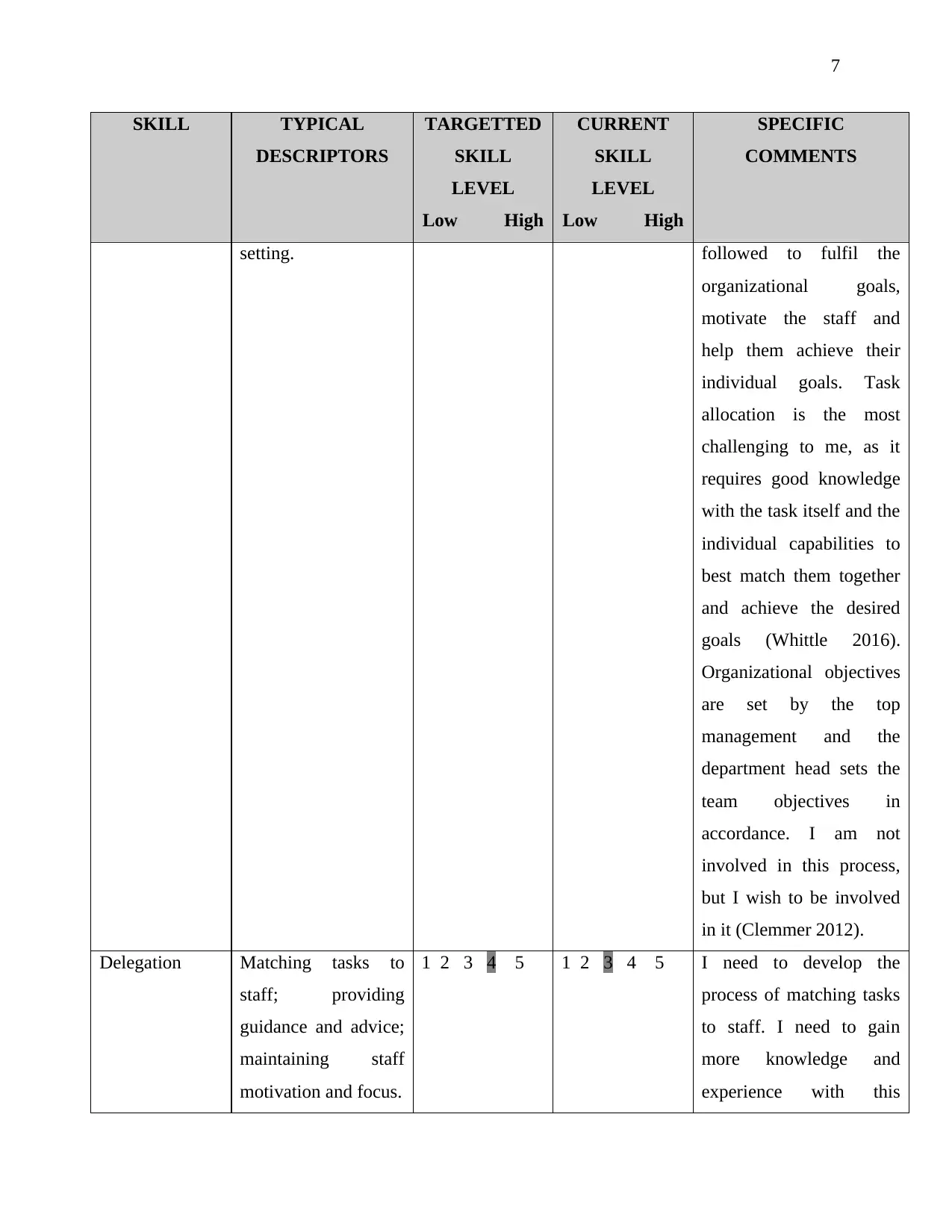
7
SKILL TYPICAL
DESCRIPTORS
TARGETTED
SKILL
LEVEL
Low High
CURRENT
SKILL
LEVEL
Low High
SPECIFIC
COMMENTS
setting. followed to fulfil the
organizational goals,
motivate the staff and
help them achieve their
individual goals. Task
allocation is the most
challenging to me, as it
requires good knowledge
with the task itself and the
individual capabilities to
best match them together
and achieve the desired
goals (Whittle 2016).
Organizational objectives
are set by the top
management and the
department head sets the
team objectives in
accordance. I am not
involved in this process,
but I wish to be involved
in it (Clemmer 2012).
Delegation Matching tasks to
staff; providing
guidance and advice;
maintaining staff
motivation and focus.
1 2 3 4 5 1 2 3 4 5 I need to develop the
process of matching tasks
to staff. I need to gain
more knowledge and
experience with this
SKILL TYPICAL
DESCRIPTORS
TARGETTED
SKILL
LEVEL
Low High
CURRENT
SKILL
LEVEL
Low High
SPECIFIC
COMMENTS
setting. followed to fulfil the
organizational goals,
motivate the staff and
help them achieve their
individual goals. Task
allocation is the most
challenging to me, as it
requires good knowledge
with the task itself and the
individual capabilities to
best match them together
and achieve the desired
goals (Whittle 2016).
Organizational objectives
are set by the top
management and the
department head sets the
team objectives in
accordance. I am not
involved in this process,
but I wish to be involved
in it (Clemmer 2012).
Delegation Matching tasks to
staff; providing
guidance and advice;
maintaining staff
motivation and focus.
1 2 3 4 5 1 2 3 4 5 I need to develop the
process of matching tasks
to staff. I need to gain
more knowledge and
experience with this
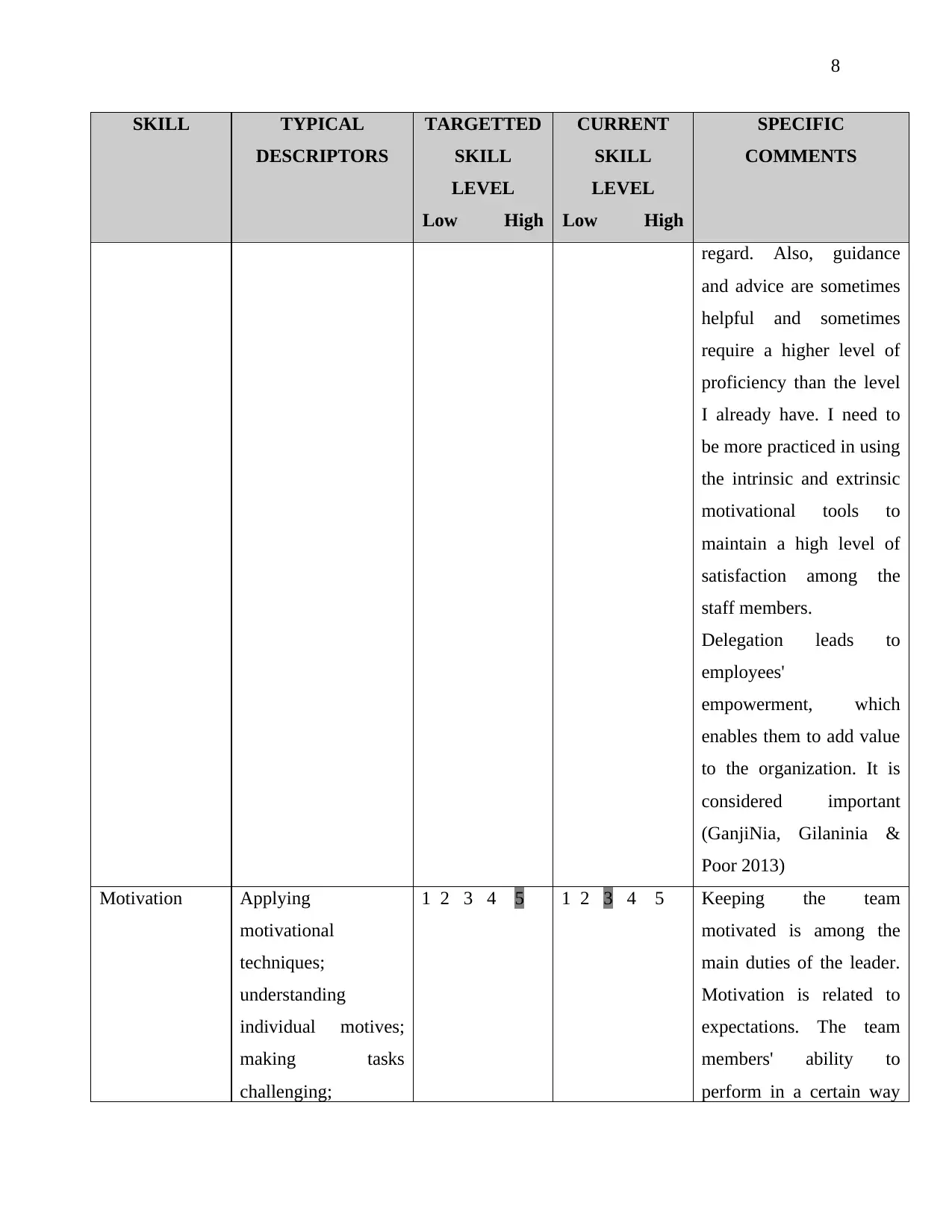
8
SKILL TYPICAL
DESCRIPTORS
TARGETTED
SKILL
LEVEL
Low High
CURRENT
SKILL
LEVEL
Low High
SPECIFIC
COMMENTS
regard. Also, guidance
and advice are sometimes
helpful and sometimes
require a higher level of
proficiency than the level
I already have. I need to
be more practiced in using
the intrinsic and extrinsic
motivational tools to
maintain a high level of
satisfaction among the
staff members.
Delegation leads to
employees'
empowerment, which
enables them to add value
to the organization. It is
considered important
(GanjiNia, Gilaninia &
Poor 2013)
Motivation Applying
motivational
techniques;
understanding
individual motives;
making tasks
challenging;
1 2 3 4 5 1 2 3 4 5 Keeping the team
motivated is among the
main duties of the leader.
Motivation is related to
expectations. The team
members' ability to
perform in a certain way
SKILL TYPICAL
DESCRIPTORS
TARGETTED
SKILL
LEVEL
Low High
CURRENT
SKILL
LEVEL
Low High
SPECIFIC
COMMENTS
regard. Also, guidance
and advice are sometimes
helpful and sometimes
require a higher level of
proficiency than the level
I already have. I need to
be more practiced in using
the intrinsic and extrinsic
motivational tools to
maintain a high level of
satisfaction among the
staff members.
Delegation leads to
employees'
empowerment, which
enables them to add value
to the organization. It is
considered important
(GanjiNia, Gilaninia &
Poor 2013)
Motivation Applying
motivational
techniques;
understanding
individual motives;
making tasks
challenging;
1 2 3 4 5 1 2 3 4 5 Keeping the team
motivated is among the
main duties of the leader.
Motivation is related to
expectations. The team
members' ability to
perform in a certain way
⊘ This is a preview!⊘
Do you want full access?
Subscribe today to unlock all pages.

Trusted by 1+ million students worldwide
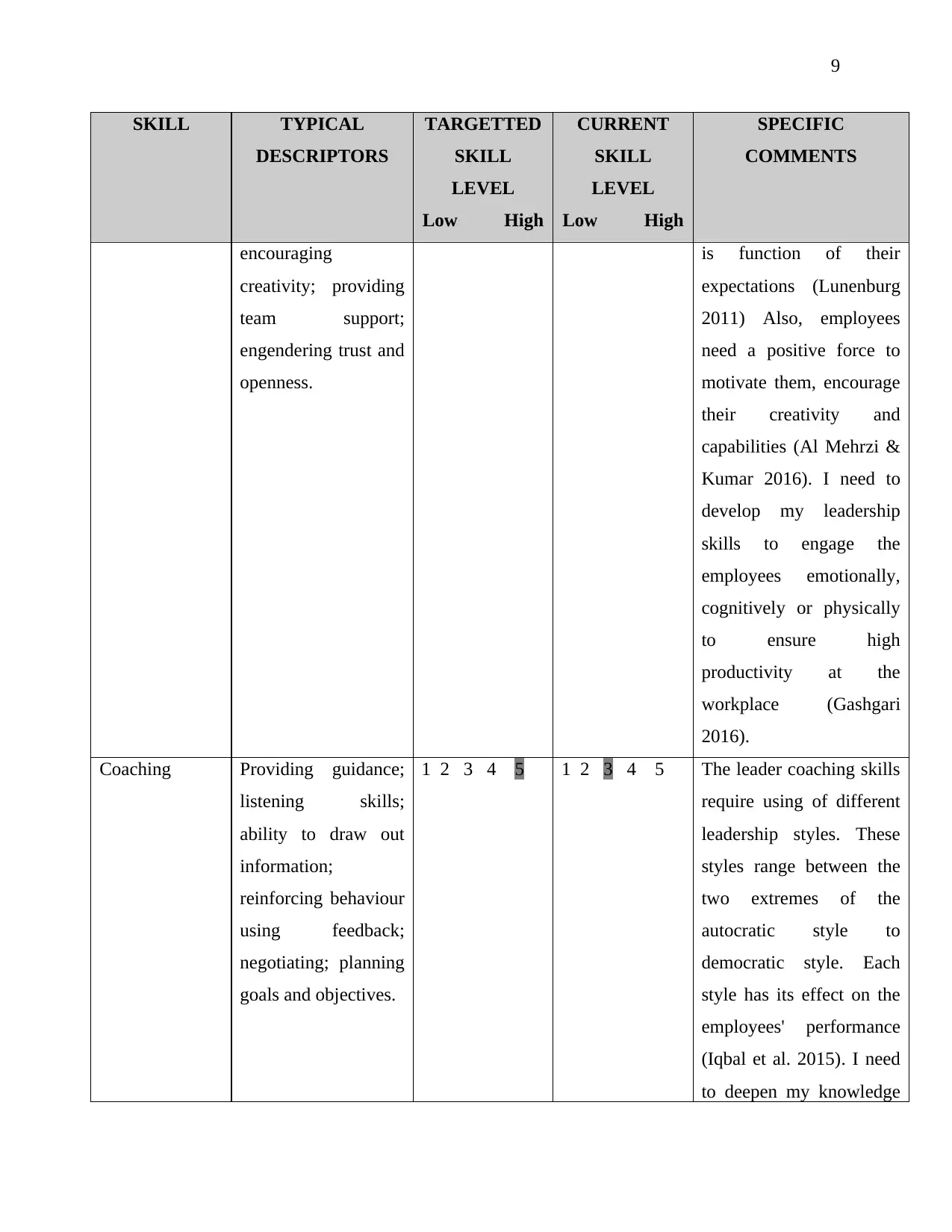
9
SKILL TYPICAL
DESCRIPTORS
TARGETTED
SKILL
LEVEL
Low High
CURRENT
SKILL
LEVEL
Low High
SPECIFIC
COMMENTS
encouraging
creativity; providing
team support;
engendering trust and
openness.
is function of their
expectations (Lunenburg
2011) Also, employees
need a positive force to
motivate them, encourage
their creativity and
capabilities (Al Mehrzi &
Kumar 2016). I need to
develop my leadership
skills to engage the
employees emotionally,
cognitively or physically
to ensure high
productivity at the
workplace (Gashgari
2016).
Coaching Providing guidance;
listening skills;
ability to draw out
information;
reinforcing behaviour
using feedback;
negotiating; planning
goals and objectives.
1 2 3 4 5 1 2 3 4 5 The leader coaching skills
require using of different
leadership styles. These
styles range between the
two extremes of the
autocratic style to
democratic style. Each
style has its effect on the
employees' performance
(Iqbal et al. 2015). I need
to deepen my knowledge
SKILL TYPICAL
DESCRIPTORS
TARGETTED
SKILL
LEVEL
Low High
CURRENT
SKILL
LEVEL
Low High
SPECIFIC
COMMENTS
encouraging
creativity; providing
team support;
engendering trust and
openness.
is function of their
expectations (Lunenburg
2011) Also, employees
need a positive force to
motivate them, encourage
their creativity and
capabilities (Al Mehrzi &
Kumar 2016). I need to
develop my leadership
skills to engage the
employees emotionally,
cognitively or physically
to ensure high
productivity at the
workplace (Gashgari
2016).
Coaching Providing guidance;
listening skills;
ability to draw out
information;
reinforcing behaviour
using feedback;
negotiating; planning
goals and objectives.
1 2 3 4 5 1 2 3 4 5 The leader coaching skills
require using of different
leadership styles. These
styles range between the
two extremes of the
autocratic style to
democratic style. Each
style has its effect on the
employees' performance
(Iqbal et al. 2015). I need
to deepen my knowledge
Paraphrase This Document
Need a fresh take? Get an instant paraphrase of this document with our AI Paraphraser
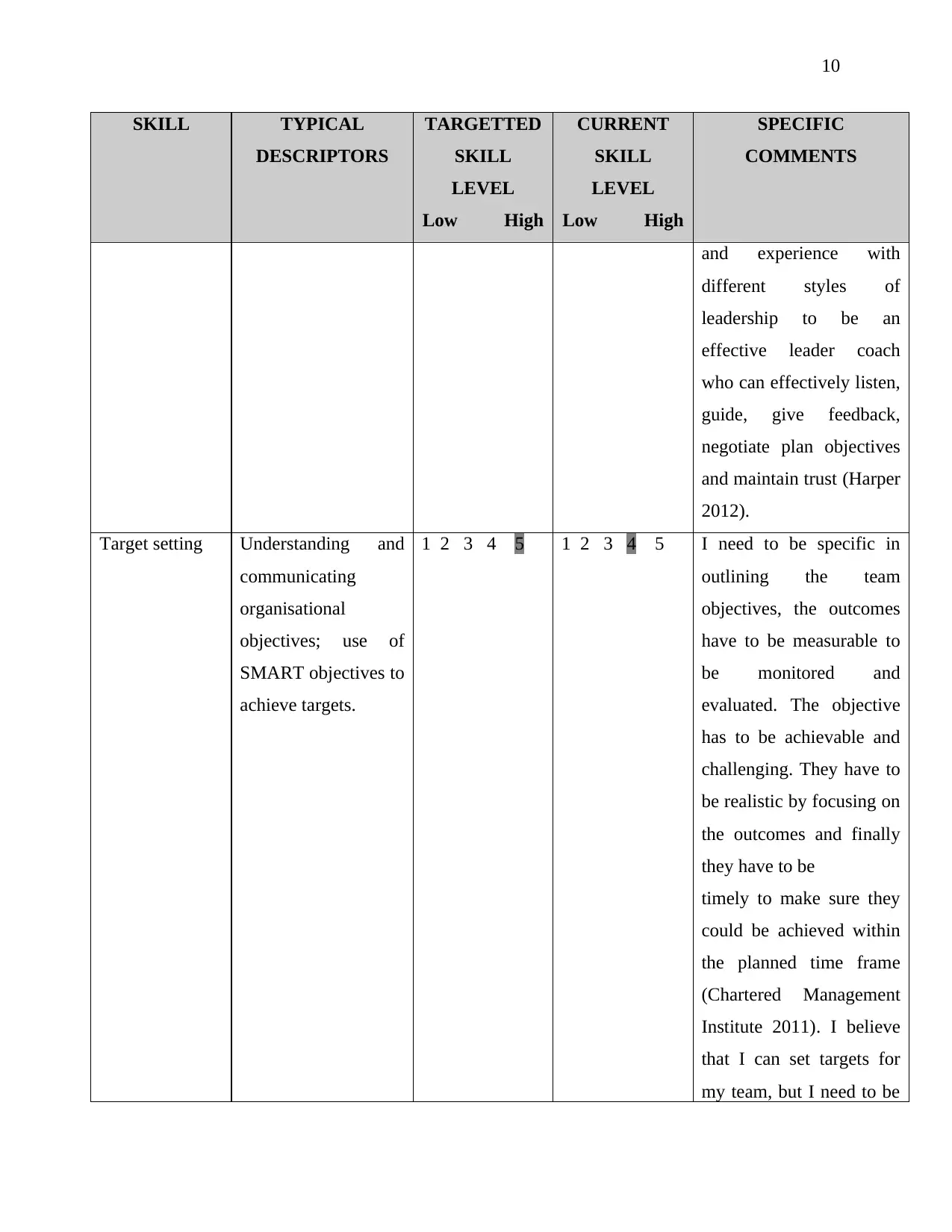
10
SKILL TYPICAL
DESCRIPTORS
TARGETTED
SKILL
LEVEL
Low High
CURRENT
SKILL
LEVEL
Low High
SPECIFIC
COMMENTS
and experience with
different styles of
leadership to be an
effective leader coach
who can effectively listen,
guide, give feedback,
negotiate plan objectives
and maintain trust (Harper
2012).
Target setting Understanding and
communicating
organisational
objectives; use of
SMART objectives to
achieve targets.
1 2 3 4 5 1 2 3 4 5 I need to be specific in
outlining the team
objectives, the outcomes
have to be measurable to
be monitored and
evaluated. The objective
has to be achievable and
challenging. They have to
be realistic by focusing on
the outcomes and finally
they have to be
timely to make sure they
could be achieved within
the planned time frame
(Chartered Management
Institute 2011). I believe
that I can set targets for
my team, but I need to be
SKILL TYPICAL
DESCRIPTORS
TARGETTED
SKILL
LEVEL
Low High
CURRENT
SKILL
LEVEL
Low High
SPECIFIC
COMMENTS
and experience with
different styles of
leadership to be an
effective leader coach
who can effectively listen,
guide, give feedback,
negotiate plan objectives
and maintain trust (Harper
2012).
Target setting Understanding and
communicating
organisational
objectives; use of
SMART objectives to
achieve targets.
1 2 3 4 5 1 2 3 4 5 I need to be specific in
outlining the team
objectives, the outcomes
have to be measurable to
be monitored and
evaluated. The objective
has to be achievable and
challenging. They have to
be realistic by focusing on
the outcomes and finally
they have to be
timely to make sure they
could be achieved within
the planned time frame
(Chartered Management
Institute 2011). I believe
that I can set targets for
my team, but I need to be
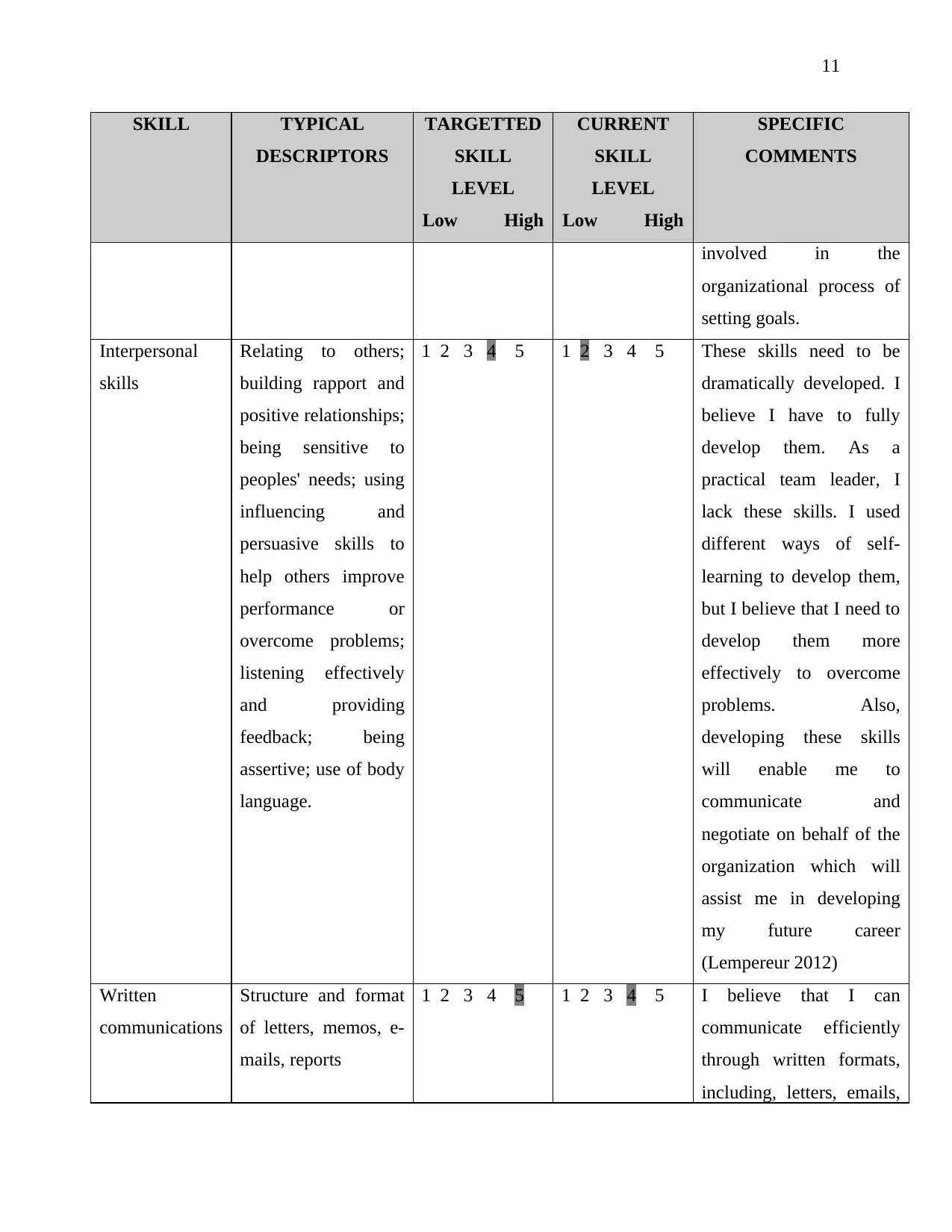
11
SKILL TYPICAL
DESCRIPTORS
TARGETTED
SKILL
LEVEL
Low High
CURRENT
SKILL
LEVEL
Low High
SPECIFIC
COMMENTS
involved in the
organizational process of
setting goals.
Interpersonal
skills
Relating to others;
building rapport and
positive relationships;
being sensitive to
peoples' needs; using
influencing and
persuasive skills to
help others improve
performance or
overcome problems;
listening effectively
and providing
feedback; being
assertive; use of body
language.
1 2 3 4 5 1 2 3 4 5 These skills need to be
dramatically developed. I
believe I have to fully
develop them. As a
practical team leader, I
lack these skills. I used
different ways of self-
learning to develop them,
but I believe that I need to
develop them more
effectively to overcome
problems. Also,
developing these skills
will enable me to
communicate and
negotiate on behalf of the
organization which will
assist me in developing
my future career
(Lempereur 2012)
Written
communications
Structure and format
of letters, memos, e-
mails, reports
1 2 3 4 5 1 2 3 4 5 I believe that I can
communicate efficiently
through written formats,
including, letters, emails,
SKILL TYPICAL
DESCRIPTORS
TARGETTED
SKILL
LEVEL
Low High
CURRENT
SKILL
LEVEL
Low High
SPECIFIC
COMMENTS
involved in the
organizational process of
setting goals.
Interpersonal
skills
Relating to others;
building rapport and
positive relationships;
being sensitive to
peoples' needs; using
influencing and
persuasive skills to
help others improve
performance or
overcome problems;
listening effectively
and providing
feedback; being
assertive; use of body
language.
1 2 3 4 5 1 2 3 4 5 These skills need to be
dramatically developed. I
believe I have to fully
develop them. As a
practical team leader, I
lack these skills. I used
different ways of self-
learning to develop them,
but I believe that I need to
develop them more
effectively to overcome
problems. Also,
developing these skills
will enable me to
communicate and
negotiate on behalf of the
organization which will
assist me in developing
my future career
(Lempereur 2012)
Written
communications
Structure and format
of letters, memos, e-
mails, reports
1 2 3 4 5 1 2 3 4 5 I believe that I can
communicate efficiently
through written formats,
including, letters, emails,
⊘ This is a preview!⊘
Do you want full access?
Subscribe today to unlock all pages.

Trusted by 1+ million students worldwide
1 out of 39
Related Documents
Your All-in-One AI-Powered Toolkit for Academic Success.
+13062052269
info@desklib.com
Available 24*7 on WhatsApp / Email
![[object Object]](/_next/static/media/star-bottom.7253800d.svg)
Unlock your academic potential
Copyright © 2020–2025 A2Z Services. All Rights Reserved. Developed and managed by ZUCOL.





